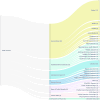Sentiment analysis in public health: a systematic review of the current state, challenges, and future directions
- PMID: 40620557
- PMCID: PMC12226299
- DOI: 10.3389/fpubh.2025.1609749
Sentiment analysis in public health: a systematic review of the current state, challenges, and future directions
Abstract
Introduction: Sentiment analysis, using natural language processing to understand opinions in text, is increasingly relevant for public health given the volume of online health discussions. Effectively using this approach requires understanding its methods, applications, and limitations. This systematic review provides a comprehensive overview of sentiment analysis in public health, examining methodologies, applications, data sources, challenges, evaluation practices, and ethical considerations.
Methods: We conducted a systematic review following PRISMA guidelines, searching academic databases through Semantic Scholar and screening studies for relevance. A total of 83 papers analyzing the use of sentiment analysis in public health contexts were included.
Results: The review identified a trend toward the use of advanced deep learning methods and large language models (LLMs) for a wide range of public health applications. However, challenges remain, particularly related to interpretability and resource demands. Social media is the predominant data source, which raises concerns about data quality, bias, linguistic complexity, and ethical issues.
Discussion: Sentiment analysis offers the potential for gaining public health insights but faces significant methodological, data-related, and ethical challenges. Reliable and ethical application demands rigorous validation, improved model interpretability, the development of ethical frameworks, and continued research to support responsible development and deployment.
Keywords: LLM; mental health; natural language processing; public health; sentiment analysis; systematic review.
Copyright © 2025 Villanueva-Miranda, Xie and Xiao.
Conflict of interest statement
The authors declare that the research was conducted in the absence of any commercial or financial relationships that could be construed as a potential conflict of interest.
Figures




Similar articles
-
Ethical and Methodological Considerations of Twitter Data for Public Health Research: Systematic Review.J Med Internet Res. 2022 Nov 29;24(11):e40380. doi: 10.2196/40380. J Med Internet Res. 2022. PMID: 36445739 Free PMC article.
-
Applications of Large Language Models in the Field of Suicide Prevention: Scoping Review.J Med Internet Res. 2025 Jan 23;27:e63126. doi: 10.2196/63126. J Med Internet Res. 2025. PMID: 39847414 Free PMC article.
-
Machine Learning and Natural Language Processing in Mental Health: Systematic Review.J Med Internet Res. 2021 May 4;23(5):e15708. doi: 10.2196/15708. J Med Internet Res. 2021. PMID: 33944788 Free PMC article.
-
Public Versus Academic Discourse on ChatGPT in Health Care: Mixed Methods Study.JMIR Infodemiology. 2025 Jun 23;5:e64509. doi: 10.2196/64509. JMIR Infodemiology. 2025. PMID: 40550010 Free PMC article.
-
Large Language Models in Medical Diagnostics: Scoping Review With Bibliometric Analysis.J Med Internet Res. 2025 Jun 9;27:e72062. doi: 10.2196/72062. J Med Internet Res. 2025. PMID: 40489764 Free PMC article.
References
-
- Nayak A, Raghatate K. Health policy reforms and their effect on healthcare delivery: Utilizing Natural Language Processing (NLP) to analyze public sentiment and policy feedback. South East Eur J Public Health. (2024). 10.70135/seejph.vi.713 - DOI
-
- Arias F, Núñez MZ, Guerra-Adames A, Tejedor-Flores N, Vargas-Lombardo M. Sentiment analysis of public social media as a tool for health-related topics. IEEE Access. (2022) 10:74850–72. 10.1109/ACCESS.2022.3187406 - DOI
-
- Adenyi AO, Okolo CA, Olorunsogo TO, Babawarun O. Leveraging big data and analytics for enhanced public health decision-making: a global review. GSC Adv Res Rev. (2024).
Publication types
MeSH terms
LinkOut - more resources
Full Text Sources

